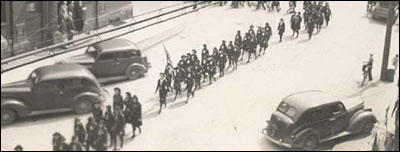Girl Guides
In April 1940, a weekly column called "Guide Notes" began to appear in the Journal. An August 1940 message to Guiders from Canada's Chief Commissioner stated, "These are the girls who will have the heavy task of helping us rebuild the world when peace comes" and urged the leaders to give the girls their best.
The Guide companies in Summerside had many projects over the war years. They raised money to buy blankets for the Red Cross. They made garments for children and layettes for babies in Britain. By March of 1942, Canadian Girl Guides across the country were sending 2000 to 3000 articles a month. In the summer of 1943 the local association gave prizes to the girls growing the best Victory Gardens.
The local girls worked tirelessly to collect paper and cardboard for at least two of the salvage drives. In March 1945 Guides sold $700 worth of War Saving Stamps during the "Stamp Out the U-boat" campaign.
In addition to these very practical endeavours, the companies also studied for badges such as the Aircraft Badge and enrolled in a War Emergency course at the Town Hall. They enjoyed a visit to the Meteorological section and saw the Flying Control Room of the RCAF Station in June 1945.
Boy Scouts
Shortly after the war started, local Scouts were collecting magazines for the Army and the Navy. They also assisted at the polls during the National Registration in August 1940.
In September 1941, the 1st and 3rd troops were re-organized with the assistance of Air Force members. In October they were collecting empty medicine bottles for the hospital at the RCAF Station. The organization floundered within months. It wasn't until December 1943 that a Boy Scouts leaders course qualified nine Summerside men to form three troops under the sponsorship of the Y's men.
In February 1944, it was announced, "the revival of scouting in Summerside is making good progress." The Oddfellows service club offered its hall for the use of the boys. Twenty-four former Scouts began to meet to learn roles as patrol leaders and seconds and troops were soon formed.
Twenty-one local boys attended the Scout summer camp at Camp Buchan near Point Prim in July 1944. That fall they held a "Copper Trail Day." This was a fundraising effort whereby the troops competed to make the longest line of copper pennies donated by the public. The successful campaign brought in money for much needed scouting supplies. During 1944, the boys also helped the Guides with the paper salvage drives.
Another Copper Trail was held in July 1945 and many of the Scouts enjoyed camp at Fernwood. In September 1945, a column titled "Scout News" began to appear in the Journal. The organization was finally on a firm footing after the uncertainties of the war years.
| Related Articles | Related Images | Related Memories | Related Websites | Inflation Calculator |
| Home Page | Site Map | Contact Us | Wyatt Heritage Properties |





